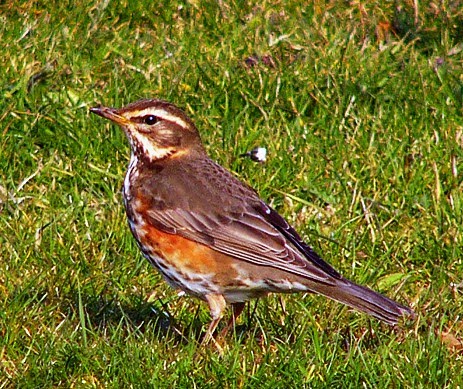Turdus iliacus
 |
| Photo by Andreas Trepte (Wikipedia) |
Common name:
Taxonomy:
Order Passeriformes
Family Turdidae
Range:
These birds breed from Iceland and the Faroe Islands, across northern and eastern Europe, and into Siberia to the Altai region and the lower Kolyma river, in Russia. They migrate south to winter in western and southern Europe, North Africa, around the Black and Caspian seas, and into south-west Asia.
Size:
Redwings are 20-24 cm long and have a wingspan of 33-35 cm. They weigh 55-75 g.
Habitat:
During the breeding season these birds are found in a wide range of habitats, including open forest margins, forest clearings, shoreline thickets, tundra willow Salix and birch Betula scrub, parks, gardens, and rocky areas. They winter in open woodland, fields, hedgerows, orchards, gardens and scrub thickets, particularly where berry-bearing bushes and grassy areas occur in close proximity.
Diet:
The redwing mostly eats invertebrates, including ants, beetles , crickets, earthworms, grasshoppers, flies, milipeds , snails, slugs and spiders. During autumn and winter their diet is often supplemented with fruits and berries, namely ivy, holly, juniper, buckthorn, currants Ribes, bramble, elder, cherry, elderberry, hawthorn, rowan, madder, apples, pears, olives, wild strawberries and even certain roots.
Breeding:
They breed in April-July. The nest consists of a bulky cup of grass, moss and twigs, bound together with mud and vegetation and lined with grass and leaves. The nest may be placed on trees, scrubs, on the ground in thick vegetation, on tree stumps, in tree hollows, or even on buildings. There the female lays 4-6 bluish-green eggs with brown blotches, which are incubated for 12-14 days. The chicks fledge 12-15 days after hatching, but continue to depend on their parents for another 2 weeks. Each pair may produce 1-2 clutches per year.
Conservation:
IUCN status – LC (Least Concern)
This species has a very large breeding range and a global population of 65-130 million individuals. The population may be facing a moderate decline, at least in Europe, but it is not threatened at present.







